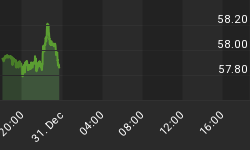In the second week since China's announcement of its decision to abandon the yuan's peg to the dollar, the reaction in global financial markets has intensified. Those who have underestimated the significance of this policy shift are running out of time to reassess their complacency. If holders of U.S. dollars were wondering for whom this bell tolled, the markets themselves are crying in crystal clarity "It tolls for thee."
During the week the price of gold gained about $10 per ounce, with the Philadelphia Gold and Silver Index (XAU) surging over 7% at its intra-week peak, its highest level since March. In additional, oil prices rose sharply as well, reaching a new all-time record high above $62 per barrel. Furthermore, the U.S. dollar posted its largest weekly decline this year, with the euro rising about 2%. In fact, by penetrating key chart resistance and forming a classic head-and-shoulders bottom in the process, the euro could rise considerably in the weeks ahead. Treasuries continued their decline, with long-term yields rising to a four month high. The technical outlook suggests that this trend will continue as well. In addition, for the first week in five, U.S. stock prices fell. Rather than a correction, it appears to me that this change of trend is likely to continue, with much steeper declines to come.
In addition, this week's economic data reveals that rather than correcting, America's unbalanced economy continues to move further off kilter. On Tuesday we learned that the personal savings rate fell to zero, the second lowest level ever, just above the minus .2% rate recorded in Oct. of 2001. Friday we learned that another 200,000 found employment in the non-productive service sector, while more manufacturing workers lost their jobs. Diminished savings and production come at a particularly inopportune time, as foreign savers are becoming more reluctant to lend, and foreign producers are growing increasingly skeptical of exchanging real goods for paper dollars.
The fact that these rather obvious signs of a looming financial crisis have gone unnoticed by traditional Wall Street investment houses is consistent with their prior history of chronic investment myopia. For example, I recently reread a Barron's article written Nov. 2, 2004, in which five Wall Strategists, myself included, where asked to predict oil prices in 2005. Of the five, I was the only one to have accurately projected higher prices (which at the time were in the upper $40 per barrel), estimating prices would reach $65-$70 per barrel. A money manager at Solomon Brothers and an energy strategist at Merrill Lynch predicted prices collapsing to $28-$35, and $31- $34, respectively. If so many Wall Street analysts could blow such an obvious call as higher oil prices, why should we expect their judgment to be any better now?
Perhaps the most ominous sign of all has been the recent increase in the local currency price of every foreign asset class in which Euro Pacific Capital clients have been investing. Capital flows of this magnitude into large cap, defensive names, reveal a major capital realignment in progress. These foreign asset classes include utilities, commercial property trusts, and oil and gas trusts, as well as energy and mining shares. The fact that demand is increasing for non-U.S. dollar, high yielding, safe-haven investments, as well as for traditional inflation and financial hedges while simultaneously decreasing for dollar denominated securities, reveals a major flow of funds taking place. Investors can either climb aboard and ride the wave to safety, or ignore its formation, and drown beneath its wake.
For my clients and myself the choice is clear. Download my free research report on the powerful case for investing in foreign equities at www.researchreport1.com, and take decisive action before the deluge.
















